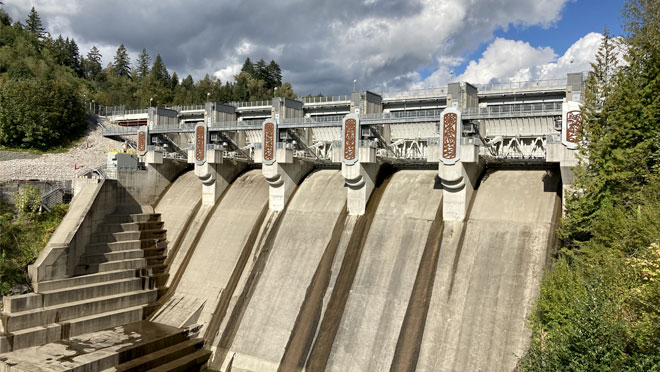Ruskin Dam

Wildfire
Wildfire standard notice
- Header
- Area notices
- Description
-
Wildfire safety
It's wildfire season. Check for fire restrictions in your area and know how to report a wildfire.
Picnic site and parking area closed
As of October 23, 2023, the Ruskin Dam picnic site and parking area are closed to the public to allow for construction starting on the Ruskin Powerhouse slope repair project.
Reservoirs popular for fishing, paddling, swimming, hiking
In the north central Fraser Valley is BC Hydro's Stave River hydroelectric project. The Stave Lake reservoir is bounded by the Stave Lake Dam. Downstream is the Hayward Lake reservoir and the Ruskin Dam.
Many recreational activities can be enjoyed in the area, from boating, fishing and swimming, to picnicking, hiking and mountain biking.
Ruskin Dam is located on the traditional territory of Kwantlen First Nation.
Where it is & what to do
About 60 km east of Vancouver, you can find the Hayward Lake reservoir recreation area, the Power House at Stave Falls Visitor Centre, and the Stave Lake boat launch.
Get Google Map directions to Ruskin Dam.
These recreation areas are provided for your use and enjoyment by BC Hydro. Please respect the facilities and natural environment by observing the following rules:
- Deposit all refuse in the containers provided.
- Pets must be on a leash at all times and are prohibited on the Hayward Lake Reservoir beach area.
- Firearms and hunting are prohibited in the recreation area.
- Vehicles left overnight on BC Hydro property may be towed at the owner's expense.
- Trails are closed to all motorized vehicles. The Reservoir Trail is closed to bicycles.
- Hayward Lake Reservoir is reserved for canoes and non-motorized boats (electric motors permitted). Stave Lake permits motorized boats.
- The consumption of liquor in public places is prohibited.
- For your own safety, avoid designated danger zones and observe all posted signs.
- The floating bridge across Hairsine Inlet will remain closed while we investigate options to reconnect the trail.
Safety information
Be alert for changing water levels, strong currents
Avoid the designated hazard areas above and below Stave Falls and Ruskin Dams and obey all posted signs. Water releases occur downstream and strong surface and underwater currents are created upstream. Swimming, boating or fishing in these areas is extremely dangerous.
On Stave Lake Reservoir, fluctuating water levels may create dangerously shallow channels for boats and expose stumps that are normally hidden. Floating debris may also be encountered.
Shoreline users must be alert, too
Changes to Stave River levels occur suddenly and without warning. Flooding may occur in low-lying areas and create dangerous conditions for fishers and other shoreline users. For your own safety, observe posted signs and be aware of rising water levels. All bodies of water (lakes, rivers and streams) represent a potential danger.
Use approved personal flotation devices, whistles
An approved personal flotation device (PFD) is required by law for each person on board any boat or canoe. This includes inflatables. Remember, it won't work if you don't wear it.
A sound signalling device, such as a whistle, is also required by law. Further requirements are outlined in the Canadian Coast Guard's Safe Boating Guide.
Other things to keep in mind:
- Do not overload your boat or canoe with people or gear.
- Watch the weather. Check the weather forecast before starting out. Be alert for the wave, wind, cloud changes that signal bad weather approaching.
- Cold water robs body heat 25 times faster than air at the same temperature. Stave Lake Reservoir, Hayward Lake Reservoir and the Stave River are cold enough to threaten your survival. Wearing your PFD increases your survival time.
- Be off the water one-half hour before posted closing times. Don't get locked inside the gate.
Swimming safety: No lifeguards on duty
There are no lifeguards on duty at Hayward, Stave, and Ruskin Recreation Areas. In the event of an accident, contact the recreation area staff and phone 911. Visitors are required to obey the safety directions of all onsite BC Hydro recreation area staff or leave the recreation area.
Never leave children without proper supervision while they are in or near the water. Children or non-swimmers should wear a PFD.
We need to fix two small sinkholes that have formed in the slope behind the powerhouse. Construction for this project is expected to take about one year.
History & hydroelectric operation
Hydroelectric developments were instrumental in shaping the history and landscape of the Stave Valley from as early as 1909 when the Western Canada Power Company Limited began the construction of a power plant at Stave Falls.
Construction of the Stave Falls Dam and Powerhouse began in 1909 and was completed by January 1, 1912.
From 1926 to 1928, the construction of an earthfill dam, tunnel and powerhouse saw the completion of the Alouette component of the regional hydroelectric system.
In 1929, construction began on Ruskin Dam and Powerhouse at the narrow granite gorge 5.6 km downstream of Stave Falls. This development created Hayward Lake Reservoir, named after Stave Falls Dam's firstp roduction superintendent.
An additional generator was installed in the Ruskin Powerhouse in 1950 to meet increased electrical demand in the region. Electric power produced at the Ruskin Generating Station is used to meet short term peak electrical demand in the Lower Mainland.
In January 2000, an upgrade to the Stave Falls Dam and Powerhouse was completed to increase the Dam's efficiency while ensuring long term hydroelectric service.
The Alouette-Stave-Ruskin generation system is a source of hydroelectricity for the Lower Mainland. Water from Alouette Lake is directed by tunnel to the Alouette Powerhouse on Stave Lake Reservoir where it then passes through the Stave Falls Powerhouse, and into Hayward Lake Reservoir. From here, water flows through the Ruskin Powerhouse and eventually down into the Fraser River.
Together, the three Powerhouses have a production capacity of 203.6 megawatts of electricity.